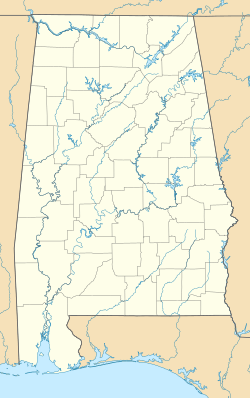- This page was last modified on 17 October 2025, at 10:18. Suggest an edit.
Kymulga Mill & Covered Bridge facts for kids
|
Kymulga Mill
|
|

Kymulga Mill near Childersburg, Alabama
|
|
| Nearest city | Childersburg, Alabama |
|---|---|
| Built | 1864 |
| NRHP reference No. | 76000356 |
| Added to NRHP | October 29, 1976 |
| Kymulga Covered Bridge | |
|---|---|

Kymulga Covered Bridge near Childersburg, Alabama.
|
|
| Coordinates | 33°20′3″N 86°18′0″W / 33.33417°N 86.30000°W |
| Carries | pedestrian traffic |
| Crosses | Talladega Creek |
| Locale | Childersburg, Alabama |
| Maintained by | City of Childersburg |
| ID number | 01-61-01 (WGCB) |
| Characteristics | |
| Design | Howe truss |
| Total length | 105 ft (32 m) |
| History | |
| Construction end | 1861 |
The Kymulga Mill & Covered Bridge are two important historical places in Talladega County, Alabama, United States. They are located inside Kymulga Park, which is found on Grist Mill Road (CR 46) off State Route 76. This park is about 4 miles (6.4 km) northeast of the city of Childersburg.
Both the mill and the bridge were built around the time of the American Civil War. They were fixed up in 1974 and were added to the National Register of Historic Places on October 29, 1976. In 1988, the Childersburg Heritage Committee bought the land. With help from the Alabama Historical Commission and the Talladega County Commission, they created Kymulga Park. More repairs were made to the structures. Today, you pay a small fee to enter the park. This money helps take care of the buildings and the nature trails in this historic area.
The City of Childersburg took over Kymulga Park in June 2011. The Childersburg Historic Preservation Commission now manages it.
Contents
Kymulga Mill: A Historic Grinding Place
The Kymulga Mill is a working gristmill that was built in 1864. A German builder named G.E. Morris constructed it for Confederate Army Major George H. Forney. Major Forney was later promoted to lieutenant colonel. Sadly, he died in the Battle of the Wilderness in Virginia before the mill was finished. However, his wife allowed Morris to complete the project.
During the Civil War, Union Army soldiers burned most gristmills in the area. But Kymulga Mill was somehow missed and survived. The mill was sold four times over the years. In 1988, the Childersburg Heritage Committee bought it from its last owner, Edward Donahoo. The mill continued to be used for many years, even with different owners.
How Kymulga Mill Works
The four-story mill used to run on power from three water turbines. These turbines powered the lights, a grain elevator, and the millstones. Millstones are large, heavy stones used for grinding grain. Two of its five sets of millstones are French buhrs. These are thought to be some of the hardest rocks in the world.
Today, Kymulga Mill still works, but it uses electricity instead of water power. It continues to make corn meal with its huge millstones. The building is now a popular place for tourists to visit. You can take guided tours to learn about its history. It also has a gift shop and serves as the park office.
Kymulga Covered Bridge: A Path Through History
The Kymulga Covered Bridge is a special bridge made of wood and metal. It crosses Talladega Creek and is located just east of Kymulga Mill, inside Kymulga Park. This bridge was built in 1861. It is 105 feet (32 m) long and uses a Howe truss design, which is a strong way to build bridges.
The Kymulga Covered Bridge is one of only two covered bridges from the 1800s in Alabama that are still in their original spot. The other one is the Waldo Covered Bridge, also in Talladega County.
Bridge's Role in History
This bridge once provided a way to get to the Old Georgia Road. This road was also known as the McIntosh Road. It was an old trade route used by Native American tribes. Later, settlers and frontiersmen used it to explore the area. Over time, farms and communities grew up along this old trail.
In 1941, the United States government bought land next to Kymulga Mill. They used it to build the Alabama Ordnance Works, which was a military base. Any towns or settlements in that area had to move.
Today, the Kymulga Covered Bridge leads park visitors to many nature trails north of Talladega Creek. If you explore, you might still find parts of the Old Georgia Road. You might also discover other clues from the past.


